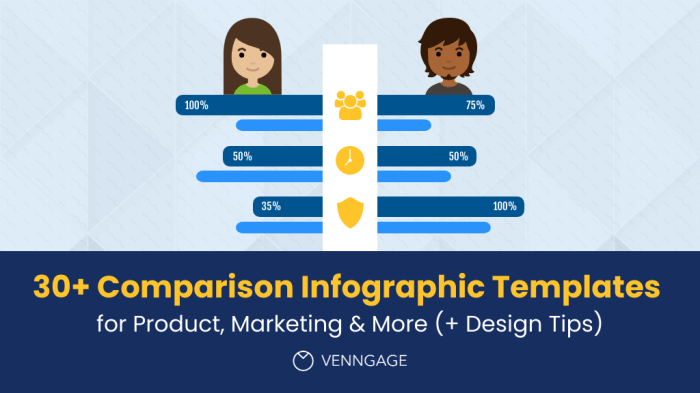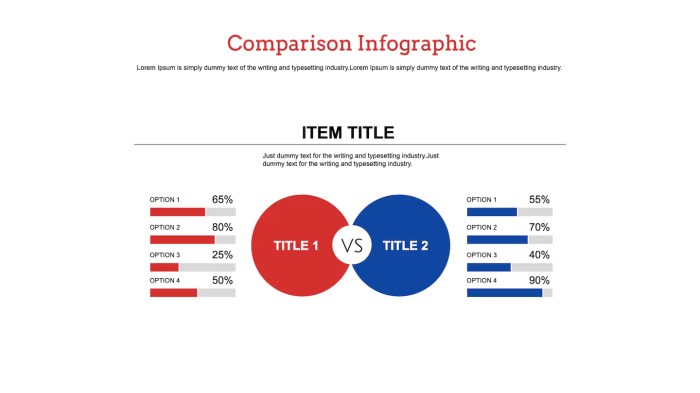Creating Comparison Content introduces a whole new dimension to content creation, exploring its significance and impact across various industries with a fresh, engaging perspective that resonates with the modern audience.
From outlining different types to structuring and writing engaging comparison content, this guide dives deep into the art and science of creating compelling content that captivates and informs.
Introduction to Creating Comparison Content
Creating comparison content involves presenting information that contrasts two or more items, products, services, or concepts to help individuals make informed decisions. This type of content is crucial in various industries as it allows consumers to evaluate options, understand differences, and ultimately choose the best fit for their needs.
Importance of Comparison Content
- Comparison content helps consumers make informed decisions by highlighting the unique features and benefits of each option.
- It builds trust with the audience as it demonstrates transparency and thorough research in presenting unbiased information.
- Comparison content can drive traffic to websites or platforms as consumers actively seek out such content before making a purchase.
Examples of Comparison Content Usage
- Product Reviews: Websites often compare different products within the same category, detailing specifications, prices, and user reviews.
- Service Providers: Comparison content is commonly used to evaluate various service providers, such as insurance companies, internet providers, or streaming services.
- Educational Resources: Students often rely on comparison content to choose the best study materials, online courses, or tutoring services.
Types of Comparison Content

When creating comparison content, it’s important to consider the different types available. Each type serves a unique purpose and can be effective in different scenarios.
Product vs. Product
Comparing products head-to-head is a common type of comparison content. This type helps consumers make informed decisions when choosing between similar products in the market.
- Example: Comparing the features, pricing, and customer reviews of two popular smartphones to help buyers decide which one suits their needs better.
Service vs. Service
When it comes to services, comparing different service providers can help consumers choose the best option based on their specific requirements.
- Example: Contrasting the pricing, customer service quality, and service offerings of two leading streaming platforms to help users decide which one to subscribe to.
Pros and Cons Lists
Creating pros and cons lists is a straightforward way to present comparison content, allowing readers to quickly weigh the advantages and disadvantages of different options.
- Example: Outlining the pros and cons of electric cars versus traditional gasoline cars to help readers understand the benefits and drawbacks of each type of vehicle.
Structuring Comparison Content
When structuring a comparison content piece, it is crucial to organize the information in a clear and concise manner to help readers easily grasp the differences and similarities between the subjects being compared. Clear headings, bullet points, and visuals play a significant role in enhancing the readability and understanding of the content.
Importance of Clear Headings
Clear headings act as signposts for readers, guiding them through the comparison content and highlighting the key points of differentiation or similarity. Headings should be descriptive and direct, providing a quick overview of what each section entails.
Utilizing Bullet Points
Using bullet points is an effective way to present information in a concise and organized manner. Bullet points help break down complex details into digestible chunks, making it easier for readers to compare the specific features or aspects of the subjects being discussed.
Enhancing with Visuals
Visual aids such as charts, graphs, and images can further enhance the comparison content by providing a visual representation of the data or characteristics being compared. Visuals help reinforce the key points and make the content more engaging and informative for the audience.
Template for Structuring a Comparison Content Article:
Below is a simple template example for structuring a comparison content article:
| Aspect | Subject A | Subject B |
|---|---|---|
| Feature 1 | Detail 1A | Detail 1B |
| Feature 2 | Detail 2A | Detail 2B |
| Feature 3 | Detail 3A | Detail 3B |
Writing Engaging Comparison Content
When creating comparison content, it’s essential to make it engaging and informative to capture the audience’s interest. Here are some tips on how to achieve that:
Use of Storytelling or Real-life Examples
One effective way to make your comparison content engaging is by incorporating storytelling or real-life examples. This helps readers relate to the content on a personal level and better understand the comparison being made.
Balance Objectivity and Opinion
It’s crucial to strike a balance between objectivity and opinion in comparison content writing. While providing facts and data is important, adding your opinion can make the content more engaging and thought-provoking. Just ensure that your opinions are backed up by evidence.
Benefits of Creating Comparison Content
Comparison content offers numerous advantages for both businesses and consumers. By providing detailed comparisons between products or services, businesses can showcase their unique selling points and help consumers make informed decisions. This type of content can significantly impact the decision-making process by highlighting key differences and similarities, ultimately guiding consumers towards a purchase.
Enhanced Decision-Making
Comparison content plays a crucial role in aiding consumers in their decision-making process. By presenting side-by-side comparisons of various options, consumers can easily evaluate the features, pricing, and benefits of each product or service. This helps them make a more informed decision based on their specific needs and preferences.
- Comparison content eliminates confusion and uncertainty by presenting clear distinctions between products or services.
- Consumers can weigh the pros and cons of each option, leading to a more rational and well-thought-out decision.
- Businesses can build trust and credibility by providing transparent and comprehensive comparison content, showcasing their commitment to customer satisfaction.
Case Studies
One notable example of the benefits of comparison content is seen in the electronics industry. Tech review websites often feature detailed comparisons of smartphones, laptops, and other gadgets, helping consumers choose the best device based on performance, price, and features. These comparisons not only inform consumers but also drive traffic and engagement for the websites, ultimately benefiting both consumers and businesses alike.
By creating comparison content, businesses can position themselves as industry experts and trusted advisors, while consumers can make confident purchasing decisions based on reliable information.
Tools and Resources for Creating Comparison Content
When it comes to creating visually appealing and engaging comparison content, having the right tools and resources at your disposal is key. From platforms for design to resources for research, here are some essential elements to consider:
Design Tools for Visual Comparison
When it comes to creating visually appealing content, design tools play a crucial role. Platforms like Canva, Adobe Spark, and Piktochart offer easy-to-use templates and tools for creating eye-catching comparison graphics. These tools allow you to customize your content with colors, fonts, and images to make it visually appealing and engaging for your audience.
Research and Data Gathering Resources
Conducting thorough research and gathering accurate data is essential for creating informative comparison content. Resources like Statista, Pew Research Center, and government databases provide reliable data and statistics for a wide range of topics. Additionally, Google Scholar and academic journals are great sources for in-depth studies and research papers to support your content with credible information.
Data Visualization Tools for Enhancing Comparison Content
To make your comparison content more engaging and easy to understand, data visualization tools can be incredibly helpful. Platforms like Tableau, Infogram, and Datawrapper allow you to create interactive charts, graphs, and infographics to present your data in a visually appealing way. These tools help you convey complex information in a clear and concise manner, making it easier for your audience to grasp the key points of your comparison.
Best Practices for Creating Comparison Content

When creating comparison content, it is essential to follow key best practices to ensure the effectiveness and reliability of your content. Accuracy, transparency, and relevancy play a crucial role in comparison content, providing value to your audience and building trust. Let’s explore some best practices in creating comparison content:
Importance of Accuracy in Comparison Content
Accuracy is paramount when creating comparison content. Make sure to gather data from reliable sources and fact-check all information before presenting it to your audience. Inaccurate content can lead to misinformation and damage your credibility.
Importance of Transparency in Comparison Content, Creating Comparison Content
Transparency is key to building trust with your audience. Clearly disclose any affiliations, sponsorships, or biases that may impact your comparison content. Being transparent helps establish credibility and fosters a stronger connection with your readers.
Importance of Relevancy in Comparison Content
Ensure that your comparison content is relevant to your target audience. Tailor your comparisons to address their specific needs, interests, and pain points. Relevancy enhances the value of your content and increases engagement among your readers.
Examples of Successful Comparison Content Campaigns
One successful example of comparison content is a side-by-side review of two popular smartphones, highlighting their features, performance, and price points. Another example includes a detailed comparison of various streaming services, outlining their content libraries, subscription plans, and user experience.












